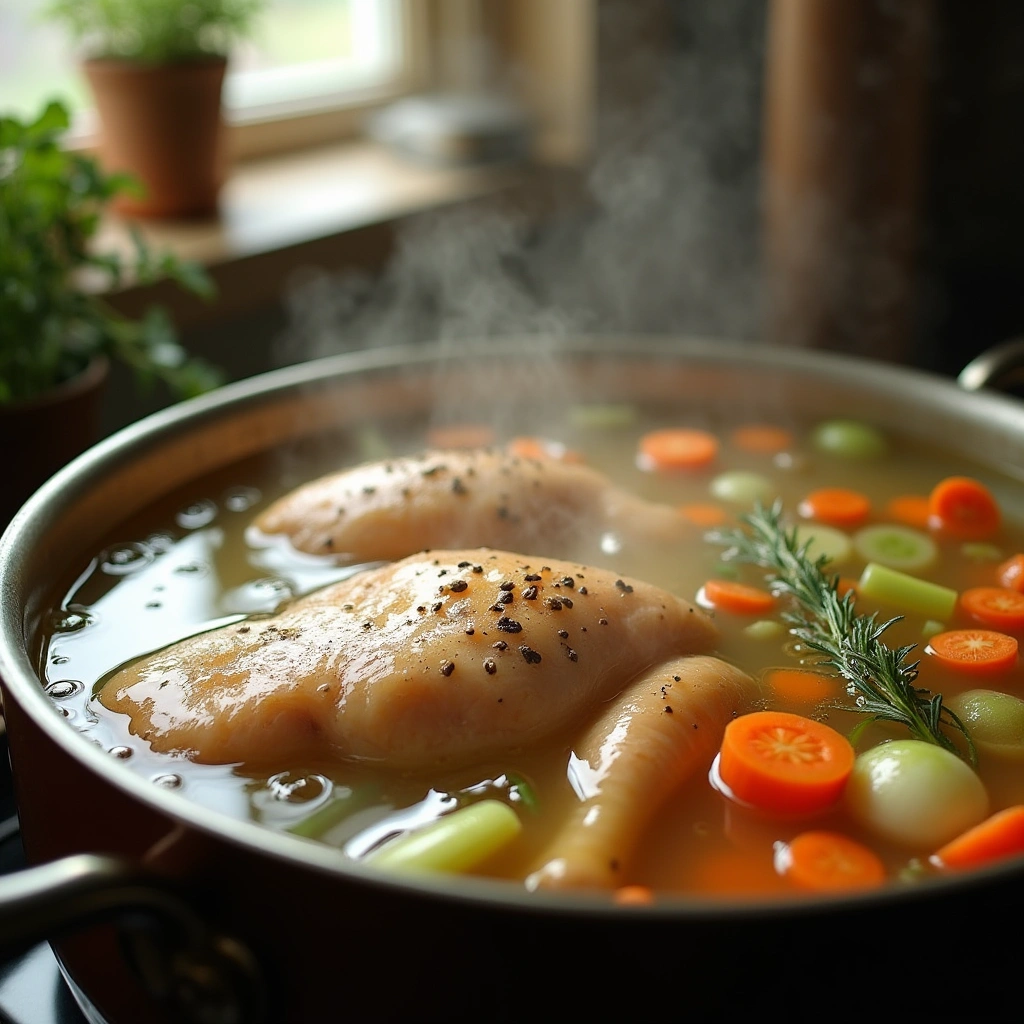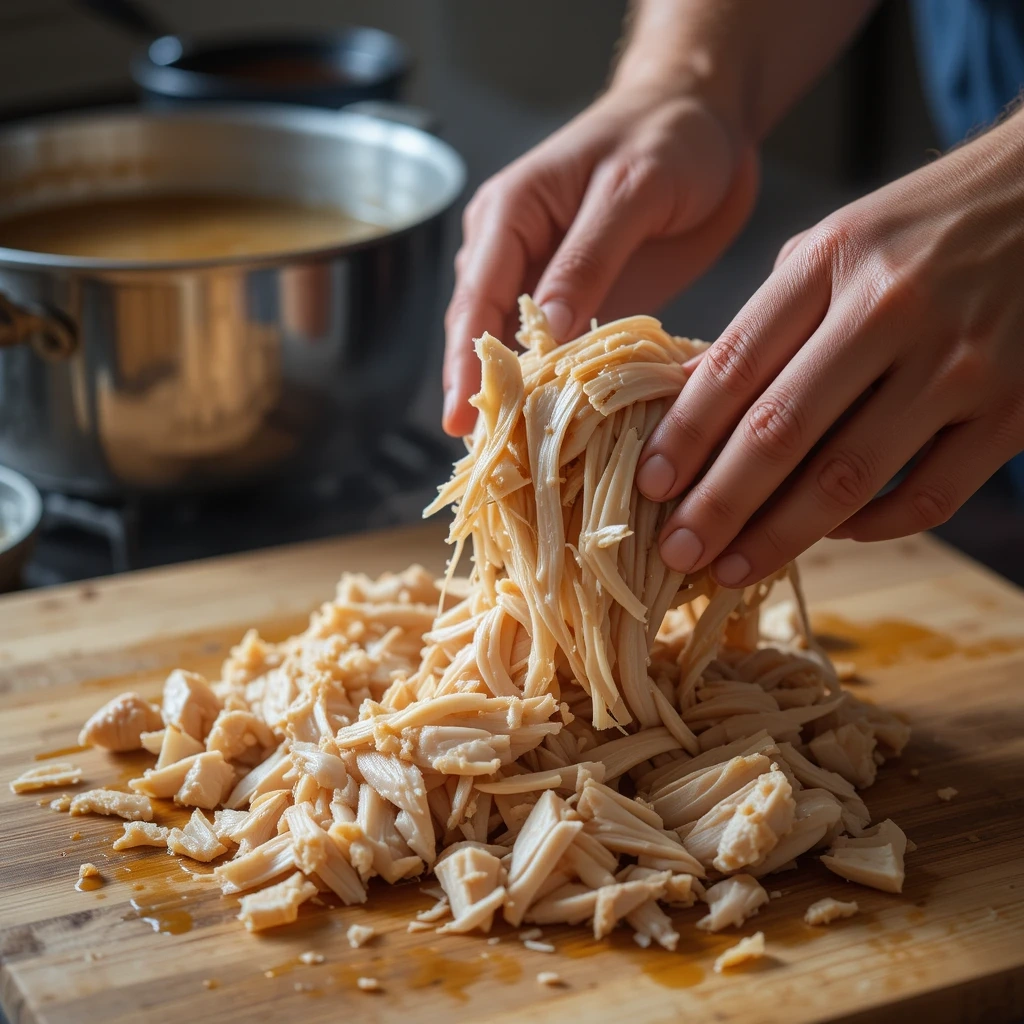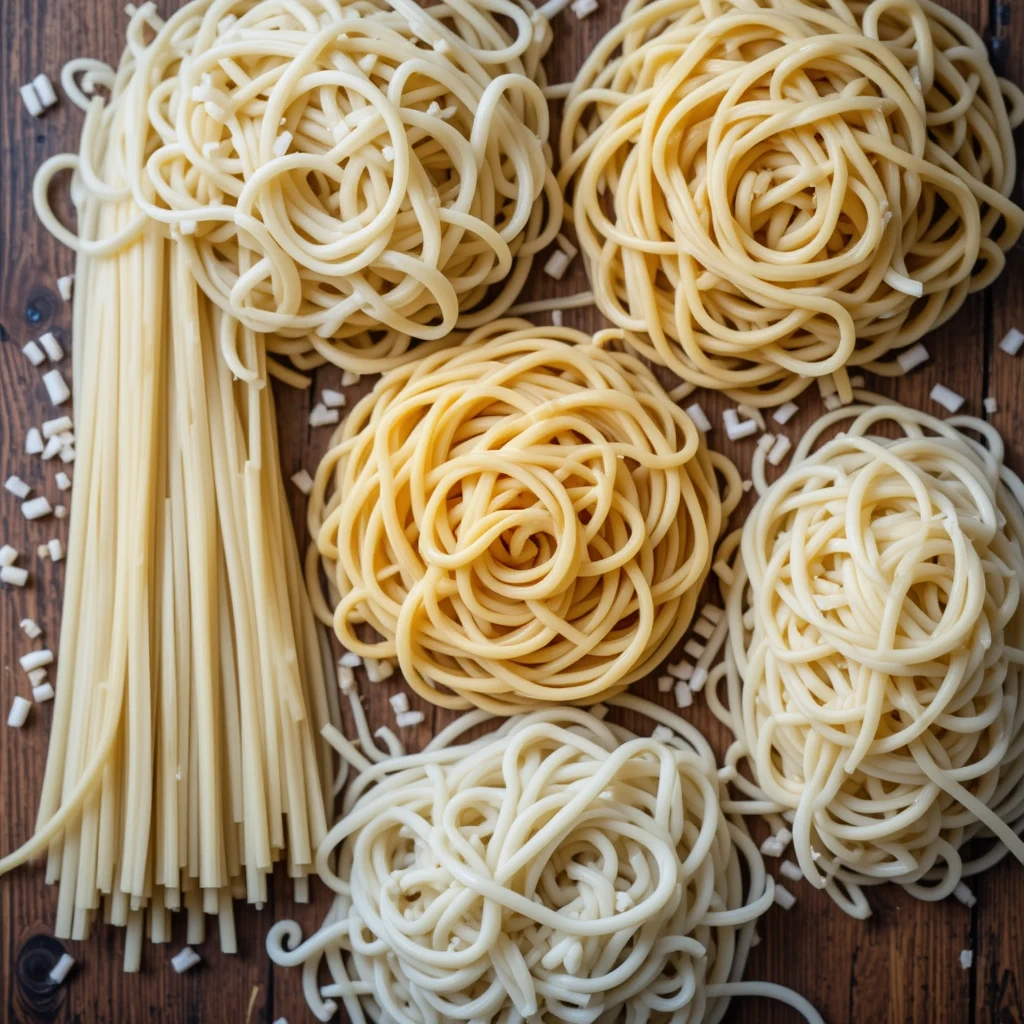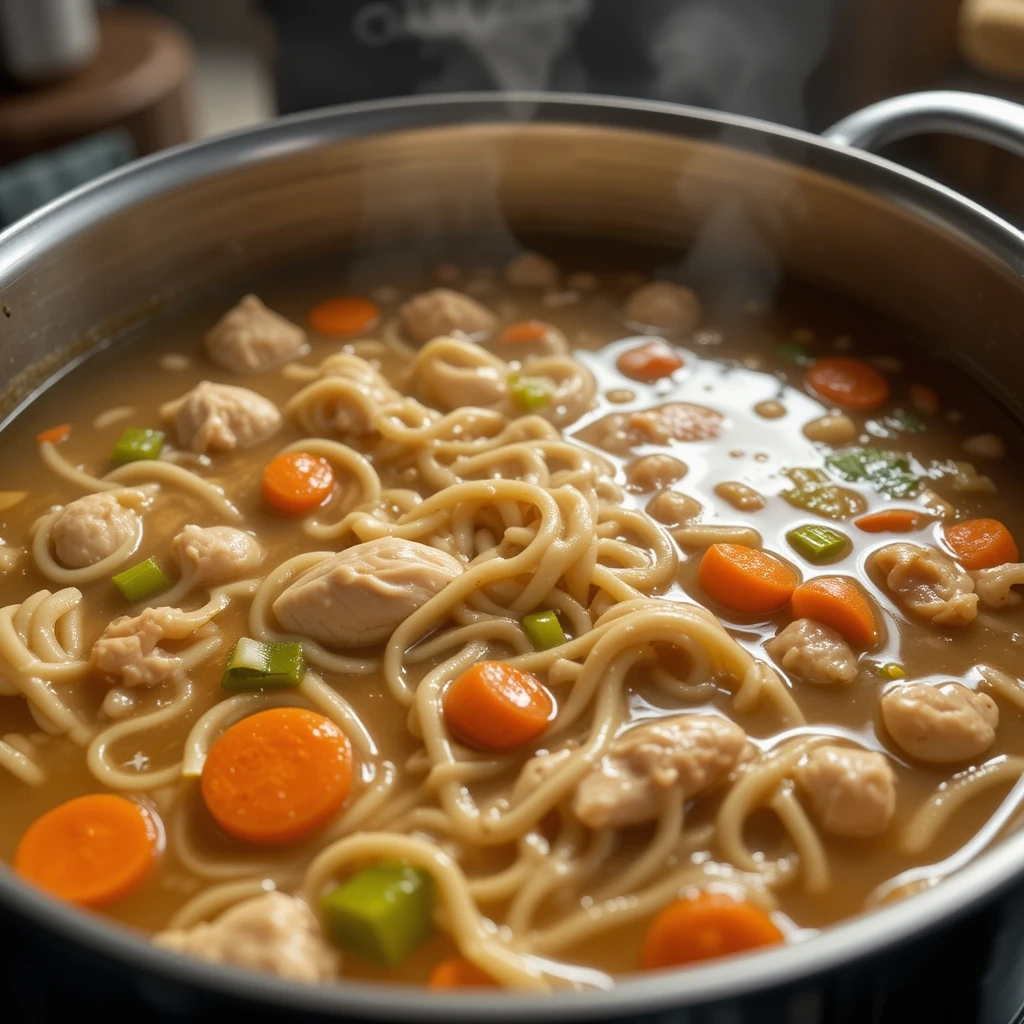Chicken noodle soup is a classic comfort food, renowned for its soothing warmth and nourishing qualities. Making the best chicken noodle soup relies on selecting high-quality ingredients, browning the chicken, and simmering the broth. Choosing the right noodles and adding flavorful vegetables and herbs are also crucial. Proper cooking techniques, such as controlling the heat and skimming impurities, further enhance the soup. Avoiding common mistakes, such as using pre-cooked chicken or neglecting seasoning, ensures a delicious final result. Served warm with fresh herbs or a lemon squeeze, chicken noodle soup is a comforting and satisfying meal.
When it comes to making the best chicken noodle soup, the foundation lies in selecting the right ingredients. I remember the first time I attempted this classic dish; I was overwhelmed by the choices at the grocery store. Should I go for organic chicken or just grab whatever was on sale?
After some trial and error, I learned that using high-quality ingredients makes a world of difference. I currently prefer chicken pieces with the bone in and skin on. They not only add depth to the broth but also provide that rich, comforting flavor that we all crave in a bowl of soup.
Equally important are the vegetables. Carrots, celery, and onions are the holy trinity of soup-making, but I’ve found that adding a few cloves of garlic and a sprinkle of fresh thyme elevates the dish to another level. Fresh herbs can transform an ordinary soup into something extraordinary.
I often visit my local farmer’s market to pick up seasonal produce, which not only supports local farmers but also ensures that my soup is bursting with flavor. The vibrant colors and fresh scents inspire me to create something truly special.
Table of Contents
Preparing the Chicken and Broth
Browning the Chicken
I start by searing the chicken pieces in a bit of olive oil until they’re golden brown. This step not only enhances the flavor but also creates those lovely fond bits at the bottom of the pot that add depth to the broth.

Simmering the Broth
After browning the chicken, I add water, along with aromatics like bay leaves and peppercorns. I let it simmer gently for at least an hour, allowing all those flavors to meld together. The first time I did this, I was amazed at how fragrant my kitchen became. The aroma wafted through my home, wrapping me in a warm embrace that felt like a hug from an old friend.

Finishing Touches
After the chicken is fully cooked, I take it out of the pot, shred it, and put it back into the broth. This process not only makes for tender chicken but also ensures that every bite is infused with that homemade goodness.

Selecting the Perfect Noodles
Choosing the right noodles is crucial for achieving that perfect chicken noodle soup experience. In my early days of soup-making, I would grab any pasta that caught my eye—often resulting in a mushy mess by the time dinner rolled around. Now, I opt for egg noodles or wide noodles specifically designed for soups.
They hold their shape well and absorb just enough broth without becoming overly soggy. I’ve also learned to cook the noodles separately and add them to each bowl just before serving. This way, they maintain their texture and don’t soak up all the delicious broth while sitting in the pot.
One memorable evening, I had friends over for dinner, and I made this adjustment on a whim. The compliments flowed as everyone enjoyed their bowls of soup with perfectly cooked noodles that didn’t turn into a gooey mass. It was a small change, but it made a significant impact on the overall experience.

Adding Flavorful Vegetables and Herbs
| Vegetable/Herb | Flavor Profile | Usage |
|---|---|---|
| Garlic | Pungent, savory | Sautéing, roasting, seasoning |
| Basil | Sweet, peppery | Salads, pasta, sauces |
| Ginger | Spicy, earthy | Stir-fries, marinades, tea |
| Thyme | Earthy, lemony | Roasted meats, soups, stews |
Vegetables are not just an afterthought in chicken noodle soup; they are essential for building flavor and texture. My go-to combination includes diced carrots, celery, and onions, but I often experiment with seasonal vegetables like peas or green beans. One winter evening, I had some leftover kale in my fridge, so I decided to toss it into the pot.
The result was a delightful surprise—adding greens not only enhanced the nutritional value but also provided a lovely contrast in color. Herbs play a pivotal role in elevating the flavor profile of your soup. Fresh parsley or dill sprinkled on top just before serving can brighten up even the most comforting of dishes.
I remember one particularly chilly day when I was feeling under the weather; I made a batch of chicken noodle soup and added a generous handful of fresh dill from my garden. The aroma filled my kitchen, and with each spoonful, I felt my spirits lift. It’s amazing how something as simple as fresh herbs can transform a dish from ordinary to extraordinary.
Looking for a nourishing and comforting meal? This Comforting Chicken and Rice Soup from Veibrant Recipes is a hearty dish that combines tender chicken, fluffy rice, and wholesome vegetables in a flavorful broth. It’s perfect for chilly days or when you need a satisfying, easy-to-make meal that warms both body and soul.veibrantrecipes.com+8eatingwell.com+8veibrantrecipes.com+8veibrantrecipes.comveibrantrecipes.com
Cooking Techniques for a Perfect Soup
Cooking techniques can make or break your chicken noodle soup experience. One of my biggest lessons came from learning to control the heat while simmering the broth. Initially, I would crank up the heat to speed up the process, but this often resulted in a cloudy broth and tough chicken.
Now, I take my time and let it simmer gently on low heat, allowing all those flavors to develop beautifully. Another technique I’ve adopted is skimming off any foam or impurities that rise to the surface during cooking. This simple step ensures a clear and clean broth that looks as good as it tastes.
The first time I did this, I was surprised at how much better my soup turned out—no more cloudy broth! It’s these little details that make all the difference in creating a comforting bowl of chicken noodle soup.

Tips for Serving and Storing
Serving chicken noodle soup is an art in itself. I love to ladle it into warm bowls and garnish it with fresh herbs or a squeeze of lemon for an extra zing. On particularly cold nights, I’ll serve it alongside crusty bread or homemade biscuits for dipping—a combination that never fails to bring smiles around the table.
One memorable dinner party featured my chicken noodle soup as the star attraction; everyone raved about how comforting it was, and we ended up sharing stories over our bowls long into the night. When it comes to storing leftovers, I’ve learned a few tricks along the way. It’s best to store the broth separately from any noodles if you plan on keeping it for more than a day or two; this prevents them from becoming mushy.
I often portion out servings into airtight containers and freeze them for those days when cooking feels like too much effort. There’s nothing quite like pulling out a container of homemade soup on a busy weeknight—it’s like having a little piece of comfort waiting for you.
Looking for a comforting and quick meal? This Quick and Easy Chicken Noodle Soup recipe from Allrecipes is a perfect choice. Ready in just about 40 minutes, it combines tender chicken, hearty noodles, and fresh vegetables in a flavorful broth. Ideal for busy weeknights or when you’re feeling under the weather, this soup is both satisfying and simple to prepare.AllrecipesAllrecipes
5 Common Mistakes to Avoid and Their Solutions
As with any recipe, there are common pitfalls when making chicken noodle soup that can lead to disappointment. One mistake I’ve made is using pre-cooked or rotisserie chicken instead of cooking it from scratch. While convenient, it often lacks that deep flavor you get from simmering raw chicken in your broth.
The solution? Embrace the process! Take your time to cook your chicken properly; you’ll be rewarded with a richer taste.
Another common error is neglecting to season adequately throughout the cooking process. Early on, I would wait until the end to add salt and pepper, resulting in bland soup. Now, I season at various stages—starting with the vegetables and adjusting as needed while it simmers.
This layering of flavors has transformed my soups from mediocre to mouthwatering. Overcooking vegetables is another mistake I’ve encountered; they can turn mushy and lose their vibrant color if left in too long. To avoid this, I add heartier vegetables like carrots and celery earlier in the cooking process while saving delicate ones like peas or spinach for just a few minutes before serving.
Lastly, using low-quality broth can lead to disappointing results. In my early days, I often relied on store-bought options without considering their flavor profiles. Now, I make my own broth whenever possible or choose high-quality store-bought varieties that are free from additives.
By avoiding these common mistakes and embracing these solutions, you’ll be well on your way to creating a comforting classic that warms both body and soul—your very own chicken noodle soup masterpiece!
FAQs
What are the key ingredients for making the best chicken noodle soup?
The key ingredients for making the best chicken noodle soup include chicken (such as bone-in, skin-on chicken thighs or breasts), chicken broth, carrots, celery, onion, garlic, noodles (such as egg
spaghetti or noodles), along with herbs such as thyme and parsley.
How should the chicken and broth be prepared for the soup?
The chicken can be prepared by either poaching or roasting it, and then shredding the meat. The broth can be prepared by simmering the chicken with vegetables and herbs in water, or by using store-bought chicken broth.
Which noodles are ideal for making chicken noodle soup?
The best noodles to use for chicken noodle soup are egg noodles, which are traditional and absorb the flavors of the soup well. Alternatively, spaghetti broken into smaller pieces can also be used.
What vegetables and herbs can be added to enhance the flavor of the soup?
Carrots, celery, onion, and garlic are commonly added to chicken noodle soup for flavor. Additionally, herbs such as parsley and thyme can be used to add depth to the soup.
What are some cooking techniques for making a perfect chicken noodle soup?
Some cooking techniques for making a perfect chicken noodle soup include sautéing the vegetables to build flavor, simmering the soup to allow the flavors to meld, and adjusting the seasoning as needed.
What are some tips for serving and storing chicken noodle soup?
Chicken noodle soup can be served with a sprinkle of fresh herbs or a squeeze of lemon juice for added freshness. Store any remaining soup in an airtight container in the refrigerator for a duration of 3-4 days.
What are 5 common mistakes to avoid when making chicken noodle soup, and their solutions?
1. Overcooking the noodles: Cook the noodles separately and add them to the soup just before serving. 2. Using bland broth: Use homemade chicken broth or enhance store-bought broth with herbs and seasonings. 3. Not seasoning the soup adequately: Taste the soup and adjust the seasoning with salt and pepper as needed. 4. Including vegetables prematurely: Add the vegetables at the final stages of cooking to maintain their texture and flavor.Using dry, flavorless chicken: Use bone-in, skin-on chicken for a more flavorful and tender meat.

chicken noodle soup
Ingredients
- Chicken pieces bone-in, skin-on
- Olive oil
- Water
- Bay leaves
- Peppercorns
- Carrots
- Celery
- Onions
- Garlic
- Egg noodles or wide noodles
- Fresh parsley
- Fresh thyme
- Salt
- Pepper
- Pros:
- Homemade flavor surpasses store-bought versions.
- Customizable with seasonal vegetables and herbs.
- Simmering develops deep and complex flavors.
- Can be frozen for easy weeknight meals.
- Comforting and nourishing especially when feeling unwell.
- Cons:
- Requires more time than using pre-cooked chicken or canned broth.
- Can be easy to overcook the noodles if not careful.
- Requires active skimming to achieve a clear broth some might find this tedious.
- Requires monitoring to avoid vegetables becoming mushy.
Instructions
- Sear the Chicken: In a large pot, sear the chicken pieces in a bit of olive oil until golden brown. This enhances the flavor and creates fond bits at the bottom of the pot.
- Simmer the Broth: After browning the chicken, add water, along with aromatics like bay leaves and peppercorns. Let it simmer gently for at least an hour, allowing all those flavors to meld together.
- Remove and Shred Chicken: Once the chicken is fully cooked, take it out of the pot, shred it, and put it back into the broth.
- Prepare Vegetables: Dice carrots, celery, and onions. Sauté them in a pan to soften them. Mince garlic and thyme to add flavor and depth. Add it to the pot.
- Cook Noodles Separately: Cook egg noodles or wide noodles separately according to package instructions.
- Combine and Season: Add the cooked noodles to the soup just before serving. Season with salt and pepper to taste.
- Serve: Ladle into warm bowls and garnish with fresh herbs or a squeeze of lemon, if desired.


1 thought on “How to Make the Best Chicken Noodle Soup: A Comforting Classic”